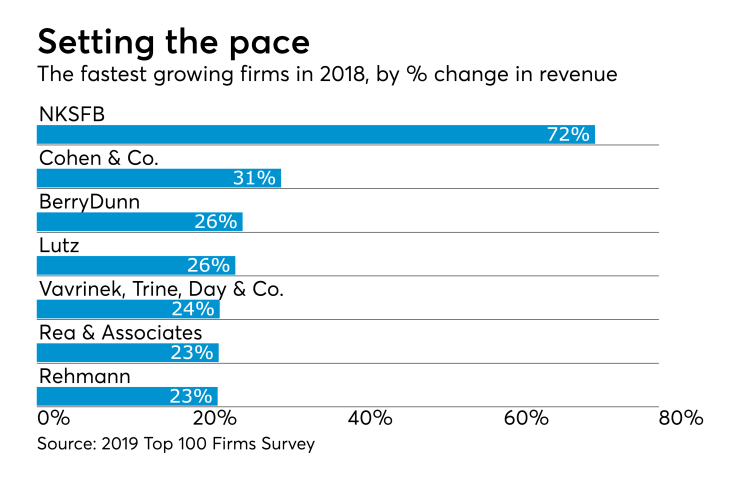When it comes to their plans for ensuring future growth, many of the 2019 Top 100 Firms are employing something of a “Chinese menu” approach: They’re picking something from Column A, something from Column B, and in many cases something from Columns C, D, E and so on.
If Chinese food isn’t to your taste, think of them as building up a suite of growth strategies across a range of areas. Whereas in the past years a single approach has often dominated — M&A in one year, intensely focusing on specialization in another, moving up the value ladder with more advisory services in another — no single strategy emerged as a strong favorite this year.
Instead, there were a number of favorites: Specialization — doubling down on specific industries and services — was the most common, with the development and pursuit of more advisory business a close second. M&A is just as popular as ever, supported by plans for geographic expansion as well as strategic alliances that expand firms’ capabilities, particularly in the tech space. Those were the most popular strategies, but they were often cited as the core of multi-part plans that involved a host of other, complementary initiatives, that firms are pursuing concurrently.
Springfield, Missouri-based BKD had perhaps the most comprehensive of these wide-ranging plans, with CEO Ted Dickman citing the following important parts of the Top 15 Firm’s growth strategies for 2019:
- Ongoing focus on recruiting, developing and retaining the best talent to serve clients.
- Benchmarking client experience, relationship and satisfaction and acting on learnings.
- Continued consideration of the right mergers, acquisitions and green-fielding expansion to augment the firm and provide new opportunities for people.
- Examining new opportunities to broaden and cross-sell additional services.
- Expanding learning & development and sales training to include a broader range of client service personnel.
- Emphasis on expanding exposure of thought leadership through email, webinars, web and social media outlets to the right targets.
- Continued focus on targeted strategic growth initiative industries & services.
- Launching firmwide service campaigns.
- Promoting a firmwide culture of innovation.
With most every tactic represented, from marketing and client service initiatives to talent development and a focus on innovation, it’s a great compendium of the many ways the Top 100 are aiming to grow — and perhaps the ultimate example of how they’re combining all of them.
Making choices
Not all firms put quite as much on their plate as BKD, but few were relying on any single avenue for pursuing growth.
Doubling down on current specialties, for instance, was a very common strategy, and one that Top 10 Firm Crowe is following: “Crowe continues to focus on its vision and strategy of ‘Deep Specialization,’” said CEO Jim Powers. “We continue to invest heavily in the industries and key markets that we serve, which includes innovation and new product development, differential service delivery platforms, outstanding industry thought leadership, deep client relationships, and providing exceptional experience for our people and our clients.” But the firm is also pursuing a “One Crowe” strategy, and aiming to grow as a technology firm at the same time.
Similarly, Pennsylvania-based RKL plans to “deepen the firm’s specializations and grow its talent in key industries” in specific sectors, according to CEO Edward Monborne. But they will also “grow our client advisory services practice to provide outsourcing solutions through a company’s entire infrastructure.” And that’s to say nothing of planned investments in technology and other resources, and deeper commitments to professional and leadership development to boost the recruiting and retention of top talent.
Higher-value-added services were part of many firms’ strategic packages. “At any given time, our clients are facing diverse and increasingly complicated challenges and opportunities … and they are seeking our guidance to help navigate all this change to a clear way forward,” said BDO USA CEO Wayne Berson. “We expect advisory to continue to grow and become a greater proportion of our revenues as we develop services and solutions to address the needs of our clients. We are growing these services organically, but in some cases, we will seek to accelerate that growth through acquisitions.”
BDO isn’t alone in the hunt for merger candidates, of course. “To keep up with the pace of change in the digital age, we continue to explore acquisitions, alliances and investment opportunities that will strengthen and expand KPMG’s capabilities and service offerings,” said Lynne Doughtie, the chairman and CEO of the Big Four firm, which amassed a stunning number of partnerships and alliances over the course of 2018 (see
“Wipfli will continue to grow through mergers and acquisitions in 2019 — looking for opportunities in new geographies as well as expanding our leadership in new and existing industries,” reported managing partner Rick Dreher, though he added that the Milwaukee-based firm will also “focus on helping our clients navigate their changing industry landscape, primarily through our value-added consulting solutions and by more efficiently delivering our core services.”

Room for more?
Specialization, advisory services and M&A may have been the most common, but they certainly weren’t the only strategies on display.
Alabama-based Warren Averett plans to “deepen existing relationships by helping clients solve needs beyond traditional accounting,” according to CEO Mary Elliott, who cited “Warren Averett 360” — a client-centered approach to understanding and addressing client needs — as an example. The firm will also be pursuing new clients in strategic niches, and looking at strategic mergers and lateral hires.
Clients are central for New York-based PKF O’Connor Davies, as well. “The most important factor as we continue to build the firm is maintaining an unmatched focus on client value and providing the best client experience possible,” said managing partner Kevin Keane. “That is why we continue to invest in infrastructure to support ongoing growth without sacrificing client service. The firm has ongoing plans to invest in our shared services areas to stay ahead of the pace of client change and to support our aggressive growth plans in a way that is smart, strategic and opportunistic.” (Note, though, that PKF OD will also continue with its strategy of highly targeted M&A, with potential opportunities for expansion in Florida and Boston being reviewed.)
And Michael Kaplan, a partner at California’s Miller Kaplan Arase, said, “2019 will be a big year for us, as we will be incorporating several client-facing changes and updates. With this, we hope to more thoroughly engage our current clients, while reaching out to prospective clients and inform them of all the ways we can improve their quality of life through our various service offerings.”
Improvements to marketing and business development were also top of mind at many firms. Virginia-based Brown, Edwards & Co., for instance, “added a new marketing and communications staff to our administrative team,” reported CEO Jason Hartman — though he noted that the firm is also pursuing mergers, and developing cross-selling strategies.
It was also important for St. Louis’ Brown Smith Wallace. “A contributing factor to our success has been the firm’s commitment to investing in marketing and business development talent, strategies and technology,” said managing partner Anthony Caleca. “As we’ve grown, our needs have evolved and the demand for marketing and business development expertise has increased exponentially. We’re adding a new role and reorganizing our team to allow our practice growth professionals to specialize and provide more consistent, proactive strategy development and support for the firm, service lines and industry niches. In addition to investing in people, we’re increasing our marketing spend to invest more in firm branding, employer branding and business development initiatives.”
The firm also plans to develop more strategies around employee engagement and retention — as will many of the other Top 100 Firms. California’s Squar Milner will also be focusing on its talent: “We have significant work opportunities and it’s a matter of making sure we have qualified individuals to perform that work,” said managing partner Stephen Milner. “Our primary growth strategy is to retain our people so we can service even more work.”
As much as firms are concerned about the impact of staff shortages, they’re also concerned about the impact of technology, and making sure they’re making the most of it. “Technology is changing the industry rapidly,” noted Christopher Geier, CEO and managing partner of Illinois-based Sikich. “Our core growth strategy is to go all-in on disruptive change and make technology a central piece of all our consulting services. We made important strides on that front in 2018 and will continue to innovate across our practice areas in 2019 and beyond.”
One final strategy that many firms are making part of their mix is innovation. “Our innovation team continues to move us into the future, enhancing efficiency and effectiveness with tools and processes, incorporating machine learning and robotic process automation,” said Blain Heckaman, CEO of Florida-based Kaufman Rossin, which is also working to create an innovative space in the new office it is designing for 2020. But while innovation is central, the firm is also focusing on building diversity in its staff and leadership, and “strategically identifying and addressing client needs for the future, [introducing or expanding] services, [developing] service differentiators, and [deepening] our professional teams in areas where we see future growth.”
The 10,000-foot view
One key takeaway here is that in the trenches, the Top 100 are diving deep into a multiplicity of individual strategies and tactics to fuel growth and expansion, but take a few steps back, and there are a few broader trends that emerge from all that specificity.
First is a renewed focus on the client: Whether it’s building up advisory services to fuel client growth, focusing on better client service, or improving marketing and business development, firms are eager to do more for clients, more efficiently, and to communicate more clearly and more often with both current and potential clients.
Second is the importance of investment: The words “invested in” were a constant refrain across firm responses; whether it was investment in technology, innovation, their physical offices, staff skills, marketing, new service lines, or something else entirely, the Top 100 Firms have recognized a need to put money into building themselves up. And this isn’t just for the short term, either; many of the investments described were long-term bets on the future direction of the profession and the economy as a whole.
Third is a willingness to innovate. Innovation itself is a growth strategy at a number of firms, but the Top 100 demonstrated a willingness to explore new approaches and new ideas in a host of areas that was unprecedented.
Taken all in all, it suggests that the Top 100 are taking growth more seriously than ever — and that 2019 should turn about to quite a year!





